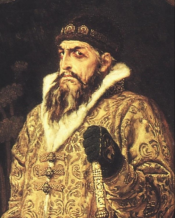
Personality of Ivan the Terrible is being explored in the Presidential Library sources
August 25, 2017, marks the 487th anniversary of the birth of Tsar Ivan IV Vasilyevich (1530—1584), whose character and acts earned him the name of Grozny. A lot of documents and materials that tell about a situation in which all contradictions of this historical person were growing ripe, and reflecting the spiritual growth and firmness in carrying out the necessary transformations in Russia have been collected in the Presidential Library stock. This is, in particular, a historical essay entitled Tsar Ivan Vasilyevich Grozny (1868), an electronic copy of which is available on the Presidential Library website, public video lecturing The epoch and a personality of Ivan the Terrible by Vyacheslav Shaposhnik, PhD in Historical Sciences, and other electronic materials of the Presidential Library.
Born in 1530, Ivan Vasilyevich was the eldest son of the Grand Duke of Moscow Vasily III and Elena Glinskaya. Three years later his father died, and the three-year-old Ivan became ruler of Russia. Under the will of Basil III until the age of 17, the boy had to remain in the custody of boyars, who in their own way were implementing this order, trying to get from this guardianship a “strategic,” as they assumed, benefit. Later, Ivan IV recalled the boyar’s foster care: “What a great need in clothes and food did we have to withstand with my brother George,” — as it articulated in a book by Nikolai Firsov entitled “Tsar Ivan Vasilyevich Grozny” (1892) from the Presidential Library fund.
In Nikolai Fomin's book of 1834, A notable marriage of Tsar Ivan the Terrible, it is said: “The character of Tsar Ivan the Terrible belongs to the number of those few characters that nature seems to appoint to revile its strength in them. Born in an unenlightened century, among the rude people, alien to education, still standing on the first stage of civil society, he showed extraordinary abilities in the wise science of governing, and, perhaps, would deprive Peter of his fame of being the first Sovereign in Russia, if the fate, to our misfortune, did not connect all possible circumstances to entice him from the path of immortality: he became a tyrant.”
The guardians of the young prince, the boyars of Shuysky, “confronted him with only disastrous thoughts about his strength, power, indulged his cruel inclinations, fulfilled all the whims, hoping to gain the favor of the future Sovereign… They wanted Ivan, forgetting their insolence, to remember only the indulgences; Ivan, on the contrary, forgot all the pleasing and remembered only frustrations,” — according to a historical essay of 1868 Tsar Ivan Vasilyevich Grozny.
In 1547, a solemn coronation of Ivan Vasilyevich for the tsardom took place in the Assumption Cathedral, from now on at his own proposition he became “Tsar of all Russia”. In the same year, Moscow was overwhelmed by the largest fires, which almost incinerated the entire city. Wearing a crown Ivan seriously thought about how to properly manage his people, to protect them from any hardship and wars. He decided, apart from just collectively, to rule inviting people from all Russian zemsky (i. e. territorial) settlements.
It was from this year that the Zemsky Sobor began assembling. Detailed information about the first veche (assembly) of the entire Russian land could be found in the above-mentioned essay of 1868 Tsar Ivan Vasilyevich Grozny: “Elected from all Russian cities and from all classes of society gathered in Moscow. Tsar opened Zemsky Sobor with his speech: “The people of God… be generous! It is impossible now to correct the past evil, I can only save you from such harassment and robbery from now on. Forget all that does not exist any more and will never happen again!” That way, under Ivan IV in old Russia the prototype of future civil society came into view.
The contribution of Ivan the Terrible to the development of the Russian state is great. During his reign, in addition to conquering the Kazan and Astrakhan khanates, Western Siberia, Bashkiria, and the lands of the Nogai Horde were annexed to the Russian state. In memory of the conquest of the Kazan Khanate in 1555, Tsar ordered to build in Moscow a church with the nine domes, which remained to the present time and is known under the name of the Cathedral of Intercession of the Virgin (Pokrovsky Cathedral) or the Church of St. Basil the Blessed.
In addition, the reforms in the military service, the judicial system and public administration, including the introduction of elements of self-governing at the local level, were carried out. Book printing began in Russia, the history of which is told in the digitized copy of a book by Mikhail Schelkunov about The history, technology, and the art of printing (1926).
In Robert Wipper's book entitled Ivan the Terrible (1922), an electronic copy of which is available on the Presidential Library website, we can read about him: “Ivan the Terrible, a contemporary of Elizabeth of England, Philip II of Spain and William III of England (Prince Orange), has to solve military, administrative and international tasks, similar with the goals of the creators of the new European powers, but in a more difficult situation: with his diplomatic and organization talents, he, perhaps, exceeds all of them.”

